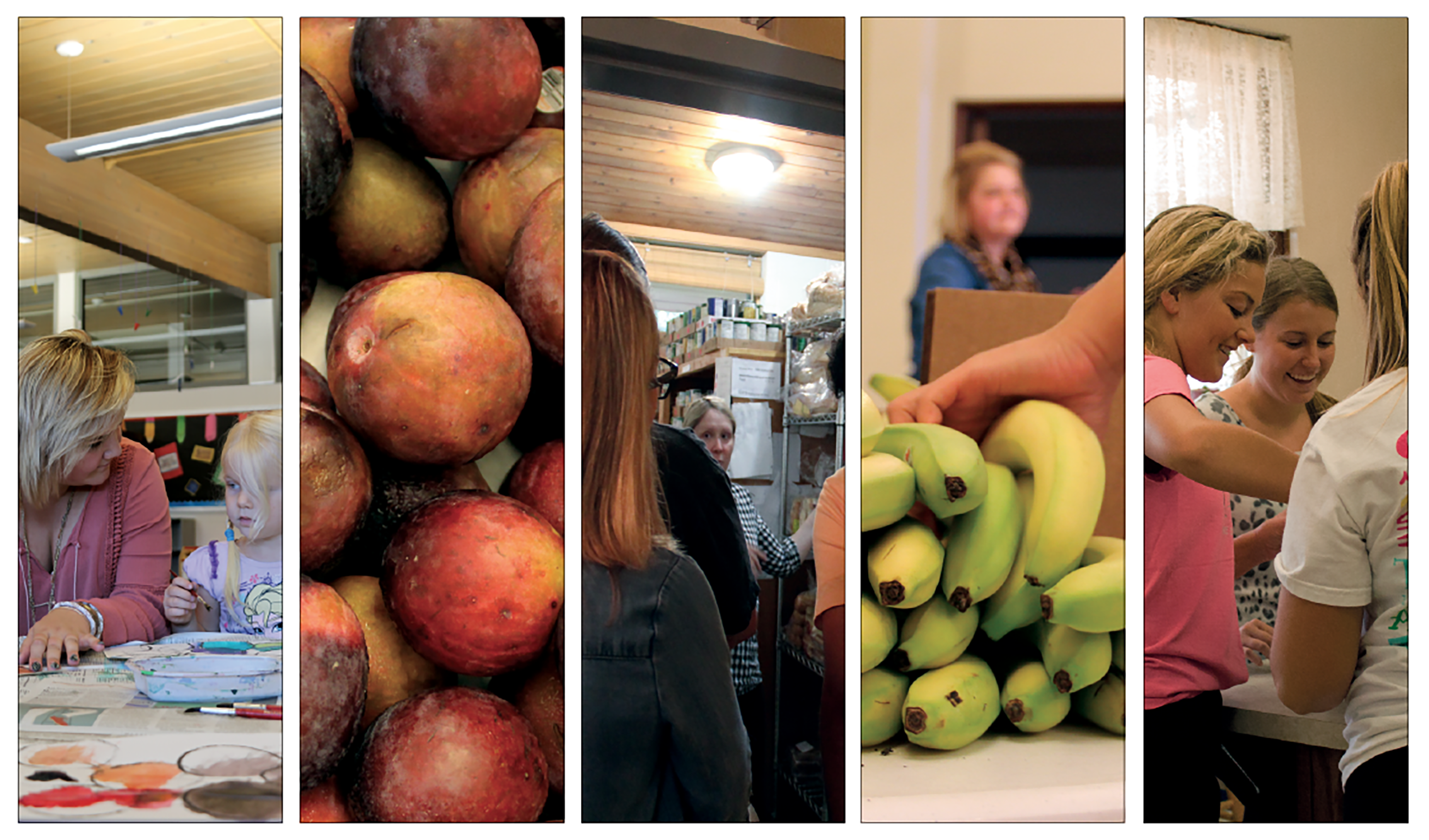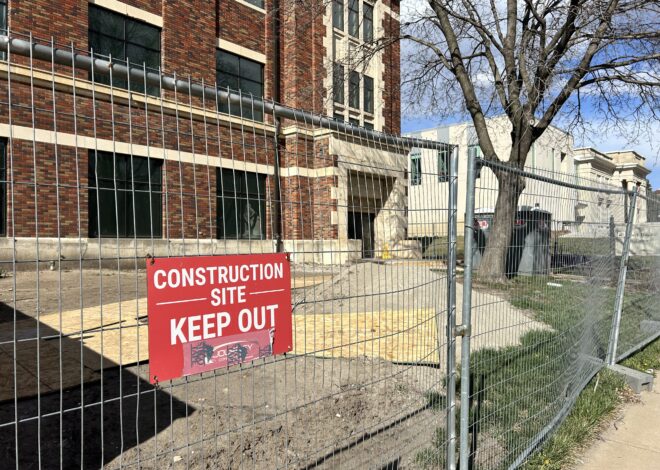
Out of sight but not out of mind: Community works to curb increasing area poverty
Vermillion, a town of about 11,000 and home to the state’s flagship university, is similar to most small towns in South Dakota. It has bars, a business district and a slew of community events. But, as a small town with little diversity in its employment opportunities, there’s a growing population of residents experiencing a very different side of the community than most USD students.
Thirty-seven percent of Vermillion’s residents are living in poverty, a four percent increase from 2010. This isn’t the only statistic that stands out in the community in relation to poverty.
According to FeedingAmerica.org, Clay County has a food insecurity rate of 16.8 percent. Vermillion’s Salvation Army provides emergency services for five to 10 people per week. The Vermillion Food Pantry served 5,000 people as of mid-September, 1,000 people ahead of last year. Welcome Table, a free meal held each week, serves about 140 people every Monday, and the Vermillion Weekend Backpack Program gives food to more than 200 children every Friday.
Jessica McKenzie, director of the food pantry, said she has come to expect this annual increase.
“We are 1,000 people ahead of last year, and that is humongous growth for a town like ours, an organization like ours,” she said. “This pantry started just in a closet, it was a tiny thing, (it) served a couple people a year. And now we’re serving thousands and thousands of people in our community.”
Often, poverty is addressed through providing schooling for uneducated people and jobs for unemployed people. However, neither is a significant issue in Vermillion, said Kelsey Collier-Wise, executive director of the United Way of Vermillion.
“We have very low unemployment in Clay County. (It’s) notably low compared to the rest of the country,” she said. “Most people in poverty are working, they just aren’t making very much money at it.”
As of 2015, Clay County had an unemployment rate of 3.1 percent. The national average is 5.3 percent.
“It’s a very interesting dynamic to try to deal with, because it’s not our stereotypical situation of an ‘easy fix,’” McKenzie said. “We still are trying to wrap our head around what exactly is causing this.”
The Clay County Poverty Task Force was formed in 2014 in order to reduce poverty and increase collaboration between like-minded organizations. Collier-Wise said the group includes all organizations that do human services work with the poverty population in Vermillion.
Increased communication and newfound partnerships between these groups has been one of its greatest successes thus far, she added.
While the task force has made progress addressing these issues, the causes behind them are less clear.
“We were hoping that we might find the silver bullet, like this is the reason why poverty is what it is,” Collier-Wise said. “And I think what we found is it’s a lot more complicated than that.”
She also said that much of the problem can be attributed to the state’s low wages.
According to the Living Wage Calculator, a single parent with one child must earn $19.89 per hour to make a livable wage in Clay County. For two working adults and two children, the hourly wage must be $13.23. The hourly wage in Vermillion is $8.55.
Collier-Wise said that many of the jobs needed to support USD are service jobs, like wiping tables at the MUC or stocking the shelves at Walmart. This often leaves little opportunity to move up in rank or pay.
“If we had more non-university-related businesses here, in a greater variety of types of employers, I think that you would see the poverty lessen,” she said.
Collier-Wise added that many of these lower-wage jobs can be filled by USD students, which makes asking for more money difficult for residents trying to support their families.
Creating a strong economy
Since Nate Welch accepted the position of Vermillion Area Chamber & Development Company (VCDC) director in 2014, addressing poverty through the diversification of Vermillion businesses has been at the forefront of his mind.
“You’re trying to solve that poverty issue by creating a good, strong economic outlook in your community,” he said.
While this has always been a priority, it’s not a process that happens quickly. Asking companies to relocate or expand isn’t an easy conversation to have, Welch said.
“We’re trying to look for good jobs,” he said. “We’re trying to look and attract good companies that will be able to stay here, that are financially strong.”
When recruiting a business, it’s also important to consider if the city has the infrastructure necessary to support it, Welch said. This could include affordable housing or other amenities the business would like to see, he added.
One resource Welch believes the city is doing a better job of taking advantage of is the talent that USD attracts and educates.
“You’ve got the law school, the medical school, the business school and all the fine arts, fantastic athletes – but we didn’t have any jobs for them,” he said. “And so what Vermillion was able to do was starting to embrace the intellect and the experience of what they have in their community, and to be able to start going after jobs that may be more appropriate for someone coming right out of school, because we’re educating them right here.”
Feeding the line
The current focus of the Vermillion Poverty Task Force is to find a building that multiple organizations can move into. Collier-Wise said the space will house the food pantry, the backpack program, Salvation Army and United Way, but other organizations can still get involved.
Collier-Wise said the process is still in its early stages — they’ve looked at a few buildings and made a list of their priorities, but haven’t made any decisions yet. She added that she anticipates some fundraising to cover the added cost, but hopes that rent can be covered by the organizations’ budgets.
In addition to increased efficiency in terms of stocking and sharing food, a communal space would also greatly benefit the organizations’ customers, McKenzie said.
“I think the most exciting thing to me is the way that our organizations will be able to collaborate in ways that we’ve never done before, and how we could be such a one-stop shop,” she said. “We’ll be able to provide a much more comprehensive look at what they need and how we can really accelerate where they are.”
Even without a shared building, McKenzie said the task force has allowed organizations to communicate like they never have before, resulting in more sharing of food and new community initiatives to help people who are food insecure, or without access to a sufficient amount of affordable, nutritious food.
The new food giveaways are an example of this increased collaboration. A three-way partnership between the backpack program, the food pantry and Feeding South Dakota, the giveaways are scheduled over Christmas break, spring break and within the first and last weeks of summer – all times of the year when students go without school lunches.
Another new resource in Vermillion to combat food insecurity is the Tanager Take-Out, a small food pantry located in Vermillion High School. Instead of participating in the backpack program, high school students can pick what they want each Friday afternoon.
In addition to letting students pick what they’d like, the Tanager Take-Out is able to provide items not possible in the backpack program, like frozen meat, toiletries and school supplies.
The pantry is open both to students and families who would prefer it over the backpack program.
“The most important part, in my mind, for that is the selection,” Lushbough said. “The kids pack what they want.”
Kelly Stone, a special education teacher at Vermillion High School, runs the Tanager Take-Out. She said the school pantry is a great way to fill the gaps in services for older students.
Stone moved to Vermillion in 1985, and has been teaching for close to 20 years. She said she wasn’t surprised to hear Vermillion’s high rates of poverty and food insecurity.
“As a teacher in our district, I fed a lot of students,” she said. “You’ll find that with most teachers. They have a side drawer with snacks, granola bars.”
Sheila Beermann, business manager for the Vermillion School District, said 31.56 percent of K-12 students in Vermillion qualify for free or reduced lunch.
So far, the Tanager Take-Out has provided food for 24 students and three families. Stone said she anticipates needs at the Tanager Take-Out growing, especially considering the number of free or reduced lunches that are provided by the schools.
Is poverty an issue in Vermillion? from The Volante on Vimeo.
A ‘constant eye opener’
Cassondra Keller, a preschool teacher at St. Agnes Elementary School, saw students receive the backpacks while she was student teaching at Austin Elementary School.
“That just made me want to get involved even more,” she said. “To see the kids get so excited about food, it made me sad but it also made me realize that I could help with that.”
Keller first got involved with the backpack program while pursuing her undergraduate degree at USD. Since then, she’s become more involved with the program, and her passion for helping food insecure children has only grown.
“To see these kids get the backpacks, it warms your heart,” she said. “Because then you know we’re doing something right, that we’re helping them for the weekend at least.”
Though there are many USD students that volunteer for local organizations, Keller said she believes more can be done.
“We’re just trying to get through assignments, we’re trying to get through tests and quizzes and our coursework and just living semester by semester — we don’t realize that so many kids in this community don’t know where their next meal is coming from,” she said.
Lushbough said he’s definitely seen more awareness among students since he started Welcome Table 16 years ago. He said the process has been a “constant eye-opener.”
Lushbough retired from teaching computer science in 2004, and said he missed having regular contact with students. Now that the majority of volunteers for Welcome Table and the backpack program are students, he gets more of that interaction he missed.
“I tell a lot of people that that’s what really keeps me going, is all the students. That student energy is unbelievable,” he said. “Having the students involved in both these programs is really, for me, is really an unbelievable thing.”
Though McKenzie believes there is still work to be done in terms of tapping into the resources that USD presents, she’s noticed more awareness of the issues in Vermillion among USD students.
“I can feel a different energy coming in with this new generation,” she said. “I think there is more awareness, especially in that age group, there’s a lot more activism to change these things.”



